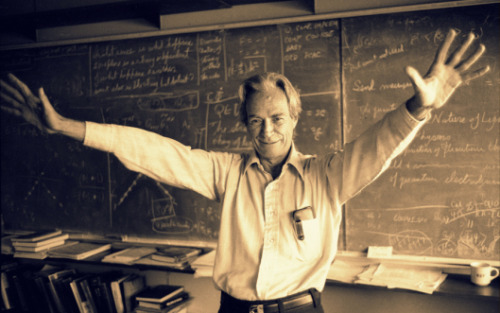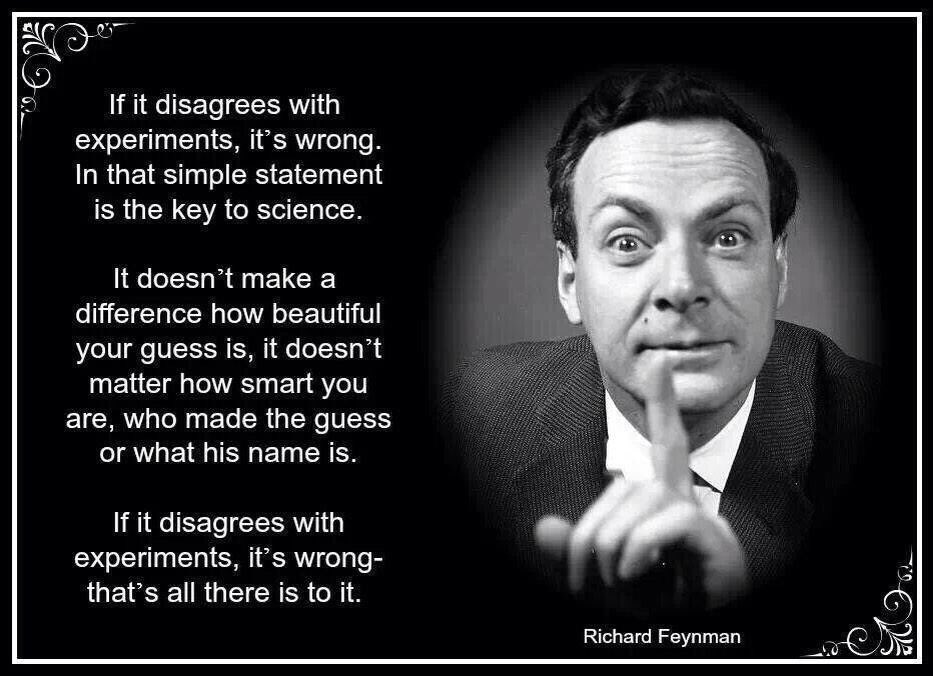Tag: Richard Feynman
“Listen to the scientists”
Guest Post by Simon Black

If there were a Mount Rushmore to memorialize the greatest scientists in US history, Richard Feynman’s face would almost certainly be on the monument.
He was only 24 years of age when he was recruited into a secret research group that eventually became part of the Manhattan Project, joining some of the other most prominent scientists of his age, like Robert Oppenheimer and Enrico Fermi.
Feynman went on to make unparalleled advances in the fields of particle physics and quantum mechanics. He conceived of nanotechnology as early as the 1950s, and quantum computing as early as 1982.
Feynman also won the Nobel Prize, plus countless other awards and medals; and he was ranked by leading scientists as one of the greatest physicists of all time– alongside Einstein, Isaac Newton, and Galileo.
CREATE YOURSELF
You are under no obligation to remain the same person you were a year ago, a month ago, or even a day ago. You are here to create yourself, continuously. pic.twitter.com/I0walAzSUz
— Richard Feynman (@ProfFeynman) October 25, 2020
WRONGLY EDUCATED
People must be educated enough to question and doubt anything from what they have been taught. But they are educated just enough to believe what they have been taught.
The problem is not that people are uneducated, the greater problem is that they are wrongly educated. ? pic.twitter.com/0wmijnFEie
— Richard Feynman (@ProfFeynman) October 20, 2020
THE PROBLEM IS……
The problem is not people being uneducated.
The problem is that people are educated just enough to believe what they have been taught, and not educated enough to question anything from what they have been taught. ? pic.twitter.com/5gBQzrou0z— Richard Feynman (@ProfFeynman) September 6, 2020
GOOD ADVICE
• Read everyday.
• Spend time with nature.
• Ask questions.
• Never stop learning.
• Don't pay attention to what others think of you.
• Do what interests you the most.
• Study hard.
• Teach others what you know.
• Make mistakes and learn.
• It's Okay to not know things!— Richard Feynman (@ProfFeynman) August 22, 2020
TEACH YOUR STUDENTS….
Teach your students
• to doubt,
• to think,
• to communicate,
• to question,
• to make mistakes,
• to learn from their mistakes, and most importantly
• have fun in their learning. pic.twitter.com/vptzzD77i0— Richard Feynman (@ProfFeynman) July 22, 2020
THROTTLE UP
“For a successful technology, reality must take precedence over public relations, for Nature cannot be fooled.” – Richard Feynman – Rogers Commission

“It appears that there are enormous differences of opinion as to the probability of a failure with loss of vehicle and of human life. The estimates range from roughly 1 in 100 to 1 in 100,000. The higher figures come from the working engineers, and the very low figures from management. What are the causes and consequences of this lack of agreement? Since 1 part in 100,000 would imply that one could put a Shuttle up each day for 300 years expecting to lose only one, we could properly ask “What is the cause of management’s fantastic faith in the machinery? … It would appear that, for whatever purpose, be it for internal or external consumption, the management of NASA exaggerates the reliability of its product, to the point of fantasy.” – Richard Feynman – Rogers Commission
The phrase “Throttle Up” jumped into my consciousness in the last week when Trump and his coronavirus task force of government hacks and bureaucrat lackeys announced the guidelines for re-opening America, as if a formerly $22 trillion economy, tied to a $90 trillion global economy, could be turned off and on like a light switch. Clap off, clap on. It just doesn’t work that way. The arrogance and hubris of people who think they can declare a global shut down for a virus and think they can easily deal with the intended and unintended consequences of doing so, is breathtaking in its outrageous recklessness and egotistical belief in their own infallibility.
BURNING DOWN THE HOUSE
Watch out you might get what you’re after
Hold tight wait till the party’s over
Hold tight We’re in for nasty weather
There has got to be a way
Burning down the house
Talking Heads – Burning Down the House

“The risk of catastrophe will be very high. The nation could erupt into insurrection or civil violence, crack up geographically, or succumb to authoritarian rule. If there is a war, it is likely to be one of maximum risk and effort – in other words, a total war. Every Fourth Turning has registered an upward ratchet in the technology of destruction, and in mankind’s willingness to use it.” – Strauss & Howe – The Fourth Turning
The risk of catastrophe is high during the climax phase of a Fourth Turning. The John Hopkins Covid-19 Dashboard above appears to portray a global catastrophe. We are in the midst of a catastrophe, but it isn’t this Chinese bio-lab virus creating the catastrophe. The catastrophe is once again being created by the Federal Reserve, their Wall Street owners, corrupt politicians, and authoritarian bureaucrats. We are burning down our house with formerly working Americans still inside.
The graphic from John Hopkins is a perfect example of globalist produced propaganda that would make Edward Bernays so proud. There are 7.8 billion people on the planet and the Covid-19 graphic gives the impression 7.5 billion people have it. The entire U.S. is covered in blood red, as if the country is being overwhelmed in disease. Of course that narrative is entirely false.
GOOD ADVICE
• Read everyday.
• Spend time with nature.
• Ask questions.
• Never stop learning.
• Don't pay attention to what others think of you.
• Do what interests you the most.
• Study hard.
• Teach others what you know.
• Make mistakes and learn.
• It's Okay to not know things!— Richard Feynman (@ProfFeynman) December 3, 2019
Love After Life: Nobel-Winning Physicist Richard Feynman’s Extraordinary Letter to His Departed Wife

Few people have enchanted the popular imagination with science more powerfully and lastingly than physicist Richard Feynman (May 11, 1918–February 15, 1988) — the “Great Explainer” with the uncommon gift for bridging the essence of science with the most human and humane dimensions of life.
Several months after Feynman’s death, while working on what would become Genius: The Life and Science of Richard Feynman (public library) — the masterly biography plumbing the wellspring of Feynman’s genius — James Gleick discovered something of arresting strangeness and splendor.
“My heart stopped,” Gleick tells me. “I have never had an experience like that as a biographer, before or since.”
The Feynman Technique: The Best Way to Learn Anything

There are four simple steps to the Feynman Technique, which I’ll explain below:
- Choose a Concept
- Teach it to a Toddler
- Identify Gaps and Go Back to The Source Material
- Review and Simplify (optional)
***
If you’re not learning you’re standing still. So what’s the best way to learn new subjects and identify gaps in our existing knowledge?
Continue reading “The Feynman Technique: The Best Way to Learn Anything”
GLOBAL WARMING “SCIENCE” EXPLAINED
It doesn't matter how beautiful your theory is, it doesn't matter how smart you are. If it doesn't agree with experiment, it's wrong. In that simple statement is the key to science.
*Cornell University Lecture, 1964* pic.twitter.com/erVFrzMbBa
— Prof. Feynman (@ProfFeynman) December 16, 2018
The Richard Feynman four-step learning method

1. Pick a topic you want to understand and start studying it. Write down everything you know about the topic on a notebook page, and add to that page every time you learn something new about it.
2. Pretend to teach your topic to a classroom. Make sure you’re able to explain the topic in simple terms.
3. Go back to the books when you get stuck. The gaps in your knowledge should be obvious. Revisit problem areas until you can explain the topic fully.
4. Simplify and use analogies. Repeat the process while simplifying your language and connecting facts with analogies to help strengthen your understanding.
And can we please bring back blackboards?
QUOTE OF THE DAY
HOW YOUR CORPORATE FASCIST GOVERNMENT MURDERED 7 ASTRONAUTS
I was using my clicker to try to find something worth watching on my 600 station FIOS TV system last night with no luck. Nothing of interest on these hundreds of worthless channels. Then I stumbled across a channel I didn’t even know I had – The Science Channel. Names don’t mean much when channels like Discovery broadcast Honey Boo Boo or Duck Dynasty. The Science Channel was running a movie called The Space Shuttle Challenger Disaster. I figured it was some sort of dry documentary, but to my surprise it was a real movie with the great actor William Hurt playing the lead role. He was playing the part of Richard Feynman. I had never heard of him before watching this excellent movie, that should have been on a major network.
I realized why a MSM corporate station didn’t want to touch this movie after it showed how our government, along with a major corporation, knowingly sent seven astronauts to their deaths in the Space Shuttle Challenger in 1986 by ignoring clear data that indicated extreme risk for that launch. NASA, the government and Morton Thiokol then conspired to cover-up their malfeasance and reckless decision making because profits and funding for their programs were more important than the lives of those astronauts. The Rogers Commission would have come to an inconclusive decision if not for Richard Feynman.
He was dying of cancer but still relentlessly pursued the truth. He never trusted authority. He hated government bureaucracy. He wasn’t a political animal. He cared about the truth and sought facts. The NASA officials lied and declared that the O-rings used in the Shuttle could withstand cold up to -40 degrees Fahrenhit. On national TV Feynman proved that the O-Rings would not retain their shape in a glass of 32 degree ice water. He revealed the NASA and Morton Thiokol executives as liars and criminals. NASA chose to launch the Space Shuttle when the temperature was below 32 degrees because they felt pressure to launch two per month in order to get their funding from Congress increased. They were warned by their own engineers that this could be catastrophic. They ignored the warnings and ended up murdering 7 astronauts.
Feynman devoted the latter half of his book What Do You Care What Other People Think? to his experience on the Rogers Commission, straying from his usual convention of brief, light-hearted anecdotes to deliver an extended and sober narrative. Feynman’s account reveals a disconnect between NASA’s engineers and executives that was far more striking than he expected. His interviews of NASA’s high-ranking managers revealed startling misunderstandings of elementary concepts. For instance, NASA managers claimed that there was a 1 in 100,000 chance of a catastrophic failure aboard the shuttle, but Feynman discovered that NASA’s own engineers estimated the chance of a catastrophe at closer to 1 in 200. He concluded that the space shuttle reliability estimate by NASA management was fantastically unrealistic, and he was particularly angered that NASA used these figures to recruit Christa McAuliffe into the Teacher-in-Space program. He warned in his appendix to the commission’s report (which was included only after he threatened not to sign the report), “For a successful technology, reality must take precedence over public relations, for nature cannot be fooled.”
The unholy alliance between government and mega-corporations will never benefit the American people. Feynman’s defeat of the corporate fascists in 1987 was nothing but a rearguard action by one of the few remaining true patriots. We’ve since lost the war, as the military industrial complex, the Wall Street cabal, and the sickcare complex have completely captured our government and turned it against the American people.
After the movie was over, they followed it with a show about his fascinating life. I can’t believe I had never heard of him. He was one of the most brilliant physicists of all-time. At the age of 27 he worked on the Manhattan Project while his 25 year old wife was dying of tuberculosis. Her death and his realization of having unleashed the power of a bomb that could destroy the world put him into a deep depression. But he overcame it and went on to become a leader in the field of quantum mechanics and the creator of nanotechnology. The documentary also mentioned how his father would read to him from the Encyclopedia Brittanica and how his father taught him to not trust government officials just because of their positions. Then I stumbled across this quote from him:
“No government has the right to decide on the truth of scientific principles, nor to prescribe in any way the character of the questions investigated. Neither may a government determine the aesthetic value of artistic creations, nor limit the forms of literacy or artistic expression. Nor should it pronounce on the validity of economic, historic, religious, or philosophical doctrines. Instead it has a duty to its citizens to maintain the freedom, to let those citizens contribute to the further adventure and the development of the human race.”
He had a deep distrust for the government and those reliant on the government. He was a free thinking, liberty minded, skeptic who questioned everything. Freedom to question the actions of your government is essential for a country to thrive. We sure could use a few more men like Richard Feynman during these critical times.











